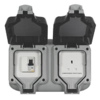The reality is those in the field rarely have enough information to make a quantitative risk assessment. So we have to do a qualitative one
The problem with that is, whether one calls it "quantitative" or not, any risk assessment has to take the magnitude of risk into account. If not, we're back to your "conceivably" again - and if one worked on the basis that virtually nothing is 'totally impossible' then regulations relating to electrical installations (and most other things), would become ludicrous and impractical!
... and the general principle is to wherever possible "stay two faults away from danger".
Again, even that requires some judgement about magnitude of risk, since it would not be practical if one were considering faults of incredibly small probability.
Having said all that, opinions about the risk assessments will obviously vary widely. In the context being discussed, if I were to use metal bushes (which I almost certainly wouldn't), I would probably earth them 'just to keep everyone happy', but not really for any other reason.
I do agree that metal CUs on TT systems are problematic, because there is no fault protection for the incoming tails and increasingly no fault protection for the busbar.
Sure, there are those additional specific concerns with TT, but ....
On TN systems I don't really see how they are any worse than any other metal electrical enclosure.
That's probably true, except that it would be rare for people to be doing much 'fiddling around' in any other metal electrical enclosure - but my argument would apply to any metal electrical enclosures in which I felt people might be doing that.
The problem is that, to use your (or BS7671's) phrase, one thing which
IS (very) "reasonably foreseeable" is that some people will 'fiddle around injudiciously' in domestic CUs and, if they do that, they will be at greater risk if there is a lot of earthed metal around for them to touch whilst 'fiddling'. The paint will hopefully protect them in most cases, but I can't say that I would want my life to be dependent upon that!
As I've said before, when it comes to things protecting people from electricity, particularly in domestic environments, non-conductors are our friends

Kind Regards, John


